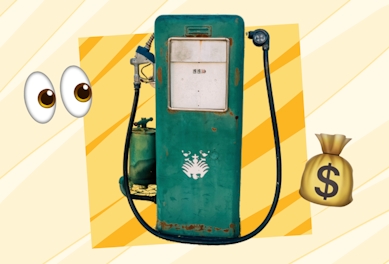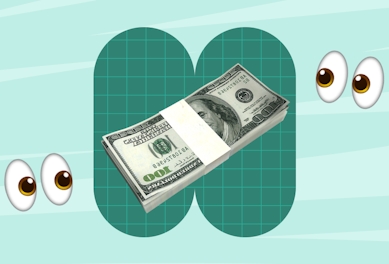Delivery Drivers: How Much They Make and How to Become One
If you’re thinking of picking up a delivery gig, you’re probably wondering how much delivery drivers make. This article gives you the facts.

Thinking about becoming a delivery driver and wondering how to rock the job and make the most money? Circuit Route Planner can help you stand out from the crowd.
If you enjoy being outside and getting some fresh air each day, delivery driving might be for you. As a delivery driver, no two days are the same. You’ll always have fresh packages to deliver, new customers to meet, and different routes to follow.
For people who value versatility and flexibility, delivery driving can be a great gig. Sounds good, right?
But no matter how enjoyable a job is, you don’t want to do it for free (or less than your labor is worth)! Your time is valuable.
So, what does the typical delivery driver earn? It depends on a few factors, including your location, the contract, and the type of delivery driving you do.
This article gives you must-know details about delivery driver salaries, and the information you need to decide if this is the gig for you. You’ll also get the insider scoop on how to score the highest-paying delivery jobs.
Let’s dive in.
How much do delivery drivers make?
Real talk: There’s no one right answer to the question, “How much does a delivery driver make?” Anyone who gives you a definitive answer to that question doesn’t have all the facts — or is ignoring some key details.
The truth is that delivery driver salaries depend on many things, from the driver’s years of experience and certifications to the type of delivery service they do.
For example, if you’re delivering valuable goods worth big bucks, you’ll likely make more than if you’re delivering something that’s less pricey.
Location is another factor that impacts how much you can earn, on average. Here’s a quick overview of the national average salary expectations for drivers in the United States, Canada, the United Kingdom, and Australia.
How much delivery drivers make in the United States
According to the United States Bureau of Labor Statistics (BLS), the demand for delivery drivers is set to increase in the years to come, with a growth of 12% — faster than average — projected from 2020 to 2030.
Here are some more fast facts about the average salary range for U.S. delivery drivers:
- Average annual salary: USD $34,340 annually (BLS)
- Average hourly wage: USD $16.51 hourly (BLS)
- Entry-level pay: The lowest 10% of drivers earn less than $22,470 (BLS).
- Experienced driver pay: The highest-earning 10% of drivers earn $70,050 (BLS).
- Highest-paying areas include: According to U.S. News & World Report, top-paying cities for delivery drivers include San Francisco, California; San Jose, California; Anchorage, Alaska; Waterbury, Connecticut; and Abilene, Texas.
How much delivery drivers make in Canada
Delivery drivers will also be in high demand in Canada in the years to come.
According to the Government of Canada’s Job Bank, an estimated 26,900 new job openings are anticipated from 2019 to 2028 — with 28,400 job seekers available to fill those slots.
Here’s some more data about the average delivery driver’s earnings in Canada:
- Average annual pay: CAD $35,360 annually (based on hourly rate given by Government of Canada, calculated according to a 40-hour workweek and 52 weeks per year)
- Average hourly rate: CAD $17 hourly (Government of Canada)
- Entry-level pay: CAD $12.75 per hour (Government of Canada
- Experienced driver pay: CAD $30 per hour (Government of Canada)
- Highest-paying areas include: According to the Government of Canada’s Job Bank, the provinces with the highest-paying delivery driver jobs are Alberta, British Columbia, Manitoba, New Brunswick, and Newfoundland and Labrador.
How much delivery drivers make in the U.K.
The U.K. is already experiencing a shortage of delivery drivers, so demand will likely remain high in the coming years.
Annual salaries for U.K. van drivers range from an estimated £16,000 to £25,000, according to the U.K. Government’s National Careers Service.
Here are some additional highlights about delivery driver salaries in the U.K.:
- Average annual pay: £21,450 annually (Talent.com)
- Average hourly pay: £11 hourly (Talent.com)
- Entry-level pay: £17,999 annually (Talent.com) or £7.86 hourly (Payscale)
- Experienced driver pay: £31,200 annually (Talent.com) or £12.14 hourly (Payscale)
- Highest-paying areas include: According to data compiled by Indeed, the highest-paying cities for delivery drivers in the U.K. are London, Manchester, Sheffield, Bristol, Exeter, Peterborough, Norwich, and Liverpool.
How much delivery drivers make in Australia
Similarly, delivery drivers will be high in demand in Australia in the years to come.
The Australian Government’s Job Outlook portal estimates strong growth over the next five years, with the number of delivery drivers growing from 72,500 to 79,800 by 2025. According to government figures, the average delivery driver in Australia earns AUD $1,010 per week.
Here are some more fast facts about Australian delivery driver salaries:
- Average annual pay: AUD $54,600 annually (Talent.com)
- Average hourly pay: AUD $28 hourly (Talent.com)
- Entry-level pay: AUD $48,750 annually (Talent.com) or AUD $17.43 hourly (PayScale)
- Experienced driver pay: AUD $65,699 annually (Talent.com) or AUD $27.38 (PayScale)
- Highest-paying areas include: According to data compiled by Indeed, the highest-paying cities for delivery drivers in Australia are Sydney NSW, Newcastle NSW, Surry Hills NSW, Canberra ACT, Sunshine VIC, Melbourne VIC, Perth WA, and Adelaide SA.
Types of delivery drivers and how they’re typically paid
Location is just one factor that can affect a delivery driver’s earnings. Your salary will also depend on just what type of goods you’re hauling.
These days, people get pretty much everything delivered, from clothes to furniture, jewelry, and beyond. Businesses also need drivers to transport goods ranging from legal documents to raw materials.
As a general rule, the more valuable the goods you’re delivering, the more you’re likely to get paid.
It makes sense, right? You’d probably be willing to pay a courier who’s delivering your legal papers more than your pizza delivery driver.
For one thing, transporting valuable goods needs a greater degree of responsibility.
Plus, in some cases, delivery drivers transporting potentially hazardous goods need additional driver credentials (more on that in the next section).
So, it’s up to you to decide whether you want the added responsibility that comes with delivering sensitive goods. If you’re looking for a low-key side hustle, you might prefer keeping your job simple and sticking to low-risk deliveries, like someone’s groceries.
Here are some types of delivery driver gigs you might consider, along with some basic info about what they’re paid:
Food delivery driver
As a food delivery driver, you transport groceries or ready-made meals. Your customers are usually hungry, so it’s important to be punctual — don’t leave them waiting!
Food delivery drivers can work for delivery apps like Instacart, DoorDash, Caviar, Shipt, Postmates, Grubhub, Eaze, and Uber Eats.
The average food delivery driver in the U.S. can expect to earn about $40,296 per year. But know that a good portion of your earnings will likely come from tips (on top of a base pay).
Amazon delivery driver
Delivery people for e-commerce retail giant Amazon transport a diversity of goods to customers, from small items like books and kitchenware to larger goods like furniture.
As an Amazon delivery driver, it’s important to prioritize orders carefully and optimize your delivery routes since certain customers, like Prime members, may request rush or 24-hour delivery.
The average Amazon delivery driver in the U.S. can expect to earn about $36,462 per year.
UPS/FedEx/DHL delivery driver
Drivers for companies like UPS, FedEx, or DHL tend to deliver more sensitive goods, like documents. Often, these items need to be handed to a physical person and can’t simply be dropped in a mailbox or on a doorstep.
These jobs need keen attention to detail and a high level of accountability. The average pay for delivery drivers for these companies is $39,900 (DHL), $40,048 (FedEx), and $62,733 (UPS).
Semi-truck driver
Truck drivers handle bigger vehicles capable of transporting large and sometimes unwieldy goods. The goods they transport might even be hazardous, such as fuel (which is flammable).
For these reasons, semi-truck drivers tend to earn more than the average delivery driver. The BLS reports the average pay for a delivery truck driver as $34,340 per year and $47,130 per year for a heavy or tractor-trailer truck driver.
How to become a delivery driver

Think a delivery driver job might be for you? As the list above shows, you’ve got plenty of options to choose from when planning your career.
But just how can you get started?
The great news is that you don’t need any higher education to get a gig as a delivery person. Some employers may ask for a high school diploma or GED, attesting to basic reading, writing, and math skills.
You might also need to do on-the-job training. Usually, this won’t take more than a month. Your training could cover points like package dropoff and return policies and what to do with damaged goods.
With these points addressed, you should be ready to join the field of delivery drivers. However, if you want to advance your career and get a higher-paying job title, there are some additional certifications you can get to earn the big bucks — more on that below.
If you decide to go for a delivery driver job, you want to make the most of it. Your success doesn’t depend on educational credentials or experience.
So, what makes a great delivery driver stand out from the pack? There are a few key traits that the best delivery drivers possess.
Master these points and you’ll excel in any delivery driver role:
Good driving skills
Let’s start with the basics. If you’re going to be driving for a living, you should be good at it!
If you’re constantly dinging cars while trying to parallel park or racking up tickets because you’re blowing past stop signs or red lights, you probably won’t be in the business for long.
Defensive driving is important, keeping you, your vehicle, and the valuable goods you deliver safe.
High level of concentration
Delivery drivers need to be alert and capable of thinking on their feet. Part of this goes hand in hand with being a safe driver — you can’t be drifting off at the wheel.
However, concentration is also important for staying on top of delivery updates, route changes, and evolving traffic patterns.
For example, if you run into a traffic jam, you need to be able to pivot and find a new route to get from A to B (this is something a route planner like Circuit Route Planner can help with).
Organizational skills
In a single workday, a delivery driver can deliver hundreds of packages.
Imagine just tossing all of those goods into the pack of your delivery van and then trying to find the right package at every stop once you get there. Talk about a waste of time.
Great drivers are well-organized and keep their vehicles orderly. That said, they also use tricks of the trade — like the Circuit Route Planner’s package finder feature — to help them stay on top of things and do their jobs well.
Attention to detail
Drivers also need to have a keen eye for detail. Often, customers will leave delivery notes with their package, for example, asking you to leave goods in a certain spot or with a neighbor.
Noticing these details and adhering to such directions can help you stand out as a stellar delivery driver.
Of course, sometimes the special requests that come with delivery orders are less serious, as this roundup of hilarious delivery driver requests proves (“Clap three times and do a backflip”?! No thanks!).
A cool head under pressure
Look, delivery driving can be a lot of fun. It’s constantly changing, gives you plenty of chances to interact with people, and allows you to get beyond the confines of a boring office.
That said, it can also be stressful!
From figuring out where the heck to take your next bathroom break to racing to meet a delivery deadline and dealing with barking dogs (friendly or unfriendly? Who knows!), there’s a lot to face. Being able to keep your cool in stressful situations is a must.
A customer service-oriented mindset
Last but not least, the best delivery drivers — the ones who stand out to clients and customers alike — are the ones who take a customer-first approach.
A friendly attitude and a smile can go a long way in this field, especially when you’re working for tips. It’s important to understand that while the delivery package in your hand may not mean much to you, it could mean a lot to your customer. It could be the highlight of their day!
Treating customers and their packages with respect is a must.
Common delivery driver certifications

For an entry-level delivery job, you’ll need a valid driver’s license registered in the state, province, or area you’ll be working in. You should also have a clean driving record — note that employers may double-check to make sure you don’t have any past issues.
While some companies — like FedEx — give you vehicles, others don’t. If your employer doesn’t give you a car, you should also have your own vehicle and comprehensive auto insurance.
These basics — a license, a car, and insurance — are enough to get you started in the field. But what if you want to advance to a higher level and earn more?
There are a few additional certifications you can get if you’re interested in more lucrative delivery jobs.
A commercial driver’s license (CDL) is the first step toward higher-paying jobs. This will allow you to drive large trucks and gain employment with corporate transport providers.
However, the name for a CDL may differ according to location. For example, while it’s called a commercial driver’s license in the U.S., you’ll need to complete what’s called a Driver Certificate of Professional Competence (CPC) in the U.K.
In Australia, there are various degrees of what’s called a “Rigid license” (Light Rigid license, Medium Rigid license, and so on). Finally, in Canada, the terminology varies according to the province — in Ontario, you’ll need a commercial vehicle operator’s registration (CVOR) certificate, for example.
Getting a CDL is usually more complex than getting an everyday license, though. You may have to pass additional practical and written tests and do a comprehensive medical exam that checks everything from your heart health to your eyesight.
You may also need to get regular medical exams to uphold your CDL. In the U.S., for example, a commercial driver has to pass a physical exam every two years. This just makes sure you’re fit to drive and not at risk of a health issue behind the wheel, like a heart attack or stroke — which could result in a serious accident, given the size of a commercial vehicle.
On top of a CDL, there are other certifications you can get to open up opportunities as a driver. For example, you can get specialty certifications that allow you to transport hazardous materials.
Frequently Asked Questions
Do delivery drivers make a lot of money?
Delivery driver earnings depend on many factors, including location, the type of goods delivered, and employer. But in the U.S., the median pay for delivery drivers is USD $34,340 or USD $16.51 per hour, according to the BLS.
That said, more experienced drivers and those in specialty fields, such as hazardous material hauling, can earn much more.
Is being a delivery driver stressful?
A delivery driver’s job is always changing, and no two days are the exact same. You’ll have new packages, customers, and routes every day, which makes your job exciting — but it can also get stressful at times.
Thankfully, the Circuit Route Planner can help minimize stress by making it easy to plan deliveries, chart routes, and keep notes on the job.
Can you make a good living as a delivery driver?
Of course, it’s possible to make a full-time living working as a delivery driver. The demand for drivers is expected to grow in the years to come, so there should be plenty of opportunities for motivated drivers to join the workforce.
The delivery field is also relatively easy to enter, as you don’t need an advanced education for an entry-level position — you’ll just need a driver’s license. This straightforward career path is great for those who don’t want to go back to school or deal with extensive training and course material to gain employment.
How do delivery drivers advance in their careers?
To advance your career, work on building a reputation of reliability and trustworthiness with timely deliveries and positive reviews from customers and employers. Rave reviews are always a great way to be recognized by management!
If you want to maximize your earning potential, also think about getting additional certifications to open up opportunities to more lucrative delivery jobs. For example, with a CDL, you can get higher-paying jobs driving heavy trucks.
Discover how the Circuit app makes route planning easy
The most successful delivery drivers get their packages where they need to go safely and punctually — and they enjoy their work. The Circuit Route Planner helps newbie and experienced drivers alike get the job done.
Our multi-drop route planner helps drivers prioritize deliveries, chart out the fastest routes, and stay on top of delivery updates. Features like a package finder, delivery notes, and proof of delivery also make the job easier.
If you’re thinking of getting a gig in the delivery field, trust Circuit Route Planner to help you succeed. Find out how it works.



